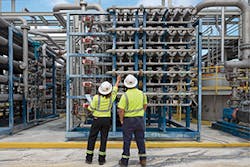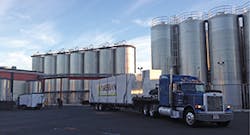Writing in its 2012 “Guidelines for Water Reuse,” EPA acknowledges that “energy efficiency and sustainability are key drivers of water reuse which is why water reuse is so integral to sustainable water management.” Furthermore, “the water-energy nexus recognizes that water and energy are mutually dependent.”
The industrial companies profiled here illustrate those words in their approach to water reuse. For decades, pulp and paper facilities, textile factories, and other facilities have been the primary industrial users of reclaimed water for cooling tower purposes. They treated and reused the water onsite. But in this century, there are new entrants.
With the drought in the Southwest impacting water use in California, Arizona, and Texas, and groundwater becoming extremely limited in Florida, municipal wastewater facilities have started producing reclaimed water and marketing it for irrigation, and to industrial and power company users.
Starting a decade ago, following the 2004 version of the guidelines, these developments have encouraged a variety of industries, ranging from electronics to food processing and the power generation industry, to reuse water in processes, boiler feed water, and cooling tower use, for toilet flushing and site irrigation.
Another push has been the Leadership in Energy and Environmental Design (LEED) certifications. Many industries and commercial and institutional establishments have sought these certifications and have used reclaimed water to enhance their green profile, according to the 2012 EPA report.
Profiled here are breweries, snack food companies, power plants, and the mining industry, which have embraced reclaimed water, not just for sustainability’s sake but for their bottom lines— and they are saving money. The report can be found online athttp://1.usa.gov/1Q2UNko.
Breweries Adopt Water Reuse
Tata & Howard Consulting Engineering Services reported that breweries, including Anheuser-Busch InBev and MillerCoors have adopted various water-saving measures, including using reclaimed water for equipment cleaning, irrigation, and other local uses. Full Sail Brewing Co. in Oregon operates a hot water recovery system and a four-day, 10-hour work week that together saves six million gallons of water per year.
Cape Cod Beer in Hyannis, MA, utilizes water reclamation and conservation efforts in their brewing process, sells their beers in refillable kegs or growlers, and donates all used and leftover grain to local farmers for feed or compost.
In California, Bear Republic Brewing Co. partnered with the City of Cloverdale to dig two new water wells and prepaid several years of water fees totaling $466,000 to finance the completion of the project. It installed a wastewater pre-treatment plant that will generate heat and electricity with the methane it produces, as well as reclaimed water for irrigation and cleaning.
In Escondido, CA, Stone Brewing Co. treats all their brewing wastewater with an aerobic digestion and filtration process, and then uses the purified water for cleaning.
Meet Ecovolt
Lagunitas Brewing Co. began inauspiciously in 1993 in the tiny town of Lagunitas in northern California near Petaluma. Speaking in a webinar sponsored by the Water Reuse Association, Eppa Rixey, strategic planning manager for Lagunitas, said the company’s first spent brewing water went into a septic tank, but the remaining yeast caused problems. Yeast eats oxygen and subsequently shut down the local septic system.
The company moved its production facility to Petaluma, where its spent water could be handled by the municipal wastewater facility. Petaluma rebuilt its wastewater facility in 2009, but because of the recession, could not expand it, and Lagunitas lost its ability to send its post-brewing water there.
The company found a home at the East Bay Municipal Wastewater Facility, but it took 10 trucks per day to haul the 50,000 gallons of contaminated water generated each day to the wastewater facility. The costs were high—80% of water costs were for wastewater disposal, says Rixey, making it difficult to grow production in the middle of the drought—so the company looked for a solution.
Lagunitas researched and found Cambrian Innovation, which had developed a bioelectrically enhanced wastewater treatment system called EcoVolt. The system came on the market in 2013.
Cambrian first produced a water audit over a two-month period, according to Matthew Silver, Cambrian’s founder and CEO, also speaking in the webinar. The audit studied the brewing processes, uses of water, and the goals and constraints of the system. The company then created designs for energy extraction, management, and secondary and tertiary treatment.
Brewing tanks at Lagunitas Brewing Co. in Petaluma, CA
The EcoVolt system begins with the high-strength spent brewing water going into an equalization tank which normalizes the flow, pH, temperature, and concentration of the water. The water is then sent through EcoVolt reactors using a bioelectrically enhanced treatment system. These reactors are stackable and at Lagunitas three reactors will eventually clean 60,000 gallons per day and generate high-quality renewable biogas.
Located next to the reactors, the EcoVolt Headworks houses integrated controls for the system which conditions the spent brewing water, handles process automation, and enables remote operation.
Rixey says the first EcoVolt reactor has been installed and cleans 20,000 gallons per day. It’s been operating for six months. “We implemented the project in stages so we could validate that the high strength brewing water could be treated by the reactors,” he says. The two additional reactors were delivered in December and will start operating as soon as they are installed.
Silver says 80–90% of the contaminants are removed from the spent brewing water at this point. The biogas is scrubbed of contaminants and burned in two 65-kilowatt Capstone Microturbines to produce 130 kilowatts, about 15% of the electricity used in the plant plus 7% of the heat needed.
Cambrian Innovation delivers the EcoVolt Reactor to Lagunitas’ headquarters in Petaluma
The EcoVolt membrane bioreactor (MBR) and reverse osmosis (RO) system will be installed by mid-summer 2016 at Lagunitas, says Rixey. The power control system for this equipment will also be housed in the same container.
The treated water will be run through the MBR and RO system to further polish the water, eventually removing 99.9% of contaminants in the spent brewing water, says Silver.
Rixey says Lagunitas produces between 105,000 and 110,000 gallons of wastewater per day and 40,000 gallons is high strength spent brewing water. Only the latter water is treated by the EcoVolt reactors. Eventually, the brewery will be treating more than 60,000 gallons per day, once all the equipment is installed, and about 70% of all wastewater on site will be reused, reducing total onsite water use by 40%.
The biggest use of water is for cleaning, explains Rixey. Beer is 90% water. In the brewing process, the grains are hydrated at warm temperatures to extract the sugars. Husks are strained out and sold to farmers for feed. “What’s left is the wort, which is boiled and hops are added, it’s cooled down and yeast is added, then fermented. Then we take out the yeast, which is sold. We’re left with finished beer, he says.” Tanks are cleaned with the reused water at that point.
A rendering of the EcoVolt water reuse process at Lagunitas Brewing Co.
“Reused water is also used for boiler makeup water, vacuum pumps, external rinses, wash downs—everything but the brewing itself. We have a good water source for the beer and want to continue to use Russian River water for the brewing side,” says Rixey.
Food Processor Reuses Water
Built in 1984, Frito-Lay’s Casa Grande, AZ, snack food manufacturing plant has become the exemplar of sustainability for the company’s 36 other manufacturing plants. It features a water reclamation system, three solar systems, and a biomass boiler that reduces gas demand to one-fifth of previous levels, making it a near net-zero facility.
Before investing in major equipment however, Frito-Lay, a subsidiary of Pepsico, improved lighting, compressed air efficiency, and outfitted motors as small as 1 horsepower with variable frequency drives.
Starting in 2010, Frito-Lay has been operating a 650,000-gallon-per-day process water recovery treatment system 24 hours per day, seven days per week. In that time it has reduced its annual water use by 100 million gallons. It recovers up to 75% of the plant’s process water.
A membrane bioreactor from GE was the first major installation. It came online in May 2010. In addition, the advanced purification system incorporates screening, sedimentation, activated carbon, ultraviolet, low-pressure reverse osmosis, water stabilization, and chlorine disinfection to treat the effluent.
According to CDM Smith, the company that designed and built the system, Frito-Lay is the first US food processing plant that produces drinking-water-quality process water to be reused in food production.
The reused water washes and moves potatoes and corn, and it is used in the boiler, according to Mohammad Haghighipodeh, sustainability manager at Frito-Lay, via e-mail. Dewatered potato peelings and corn kernels are sent to local farms for feedstock and recovered potato starch is sold for other manufacturing uses. The plant now sends less than 1% of its overall waste to landfills.
Haghighipodeh says Casa Grande parent company, Pepsico, diverted 93% of its waste through recycling and reuse in 2014, the remaining 7% going to landfills.
Frito-Lay installed a 5-MW photovoltaic solar system on land previously used for the pre-treatment and land application of wastewater. The system, also installed by CDM Smith, is made up of 18,000 panels on 36 acres, consisting of single-axis concentrated collectors that tack the sun east to west and three dual-axis ground-mount systems that align panels with the sun’s point in the sky. Also installed were 10 dish collectors lined with parabolic mirrors utilizing Sterling dish technology. The system powers a healthy proportion of theplant’s daytime manufacturing process.
ready for shipment to customers
When asked if water reuse systems have been installed at Frito-Lay’s 36 other manufacturing plants, Haghighipodeh writes, “We are focused on continuously seeking increased water efficiency at all our manufacturing facilities. The water reclamation system was a right fit for our Casa Grande facility. We have developed other process and equipment modifications at other facilities based on their specific locations and needs.”
Munis Partner With Industry
The state of Florida continues to face periodic water shortages and an increasing population. In 2013, the state reused 719 million gallons of reclaimed water per day to conserve freshwater supplies and replenish rivers and aquifers, representing 45% of wastewater currentlybeing reused in the state.
In the late 1980s a state regulation established the promotion of water reuse as a state objective. All wastewater treatment plants were required to promote the use of reused and reclaimed water and comprehensive rules governing reuse were established by the Department of Environmental Protection. Florida continues to experience rapid growth in the use of reclaimed water.
In 2014, the state legislature passed a bill that directs the Department of Environmental Protection to conduct a comprehensive study to determine how the use of reclaimed water, stormwater, and excess surface water could be expanded to assist in meeting future demands. The study report has recently been published and is available on the department’s website, www.dep.state.fl.us.
The two case studies described below are examples of municipal wastewater districts working hand-in-hand with industries to use reclaimed water supplies in lieu of higher quality sources where feasible. Approximately 17% of Florida’s reclaimed water is used by industries.
Duke Energy is now receiving between 750,000 and 800,000 gallons per day of reclaimed water from the City of Crystal River’s wastewater treatment plant to desulferize flue gas in two of its coal-burning plants at its Crystal River energy complex.
The city built a 1.5-million gallon storage tank, filtration, and pumping infrastructure, plus 7 miles of pipe to Duke’s complex that cost roughly $8.2 million. The project came online July 1, 2015.
Using reclaimed water has reduced Duke Energy’s withdrawal of fresh groundwater to an average of 2.15 million gallons per day from roughly 3 million gallons per day for use in the two coal-fired plants. They were built in the 1980s and generate 1,536 MW.
After the city upgrades its sewer system and increases wastewater treatment at the city facility, Duke will be able to reduce its groundwater intake to 1.5 million gallons per day.
The project came together as a partnership between the city, Duke Energy, the Florida Department of Environmental Protection, and the Southwest Florida Water Management District, according to Heather Danenhower, a spokesperson for Duke Energy.
Danenhower says flue gas desulfurization scrubs the sulfur from the flue gas before it is released to the atmosphere as water vapor. Water is mixed with limestone to make a slurry which is then sprayed on the flue gas. Sulfur dioxide is reduced by 97%. The process creates a synthetic gypsum as a byproduct. She says the synthetic gypsum is sold to wallboard manufacturing companies that make drywall and to farmers who use it as fertilizer.
Until the reclaimed water project was built, the city discharged its wastewater daily to a spreading field, which led to nutrients such as nitrogen and phosphorus running into the Crystal River/Kings Bay natural watershed. Discharges to the spray field now occur only two times per year.
Phosphate Mining Adopts Reuse
In mining, water is used for many activities including mineral processing, dust suppression, and slurry transport, among other uses. Use of and impacts on water in the mining industry can result in a range of environmental, social, and economic risks. In response, mining companies are developing innovative ways to respond to these risks.
Close-up of reverse osmosis system membranes treating spent process water
As an illustration, the Mosaic Co. has created a major sustainability program to reduce water and energy use and to responsibly rehabilitate the land following mining operations.
Mosaic is one of the world’s leading producers and marketers of concentrated phosphate and potash. It mines phosphate rock from land in central Florida and mines potash from four mines in North America, primarily in Saskatchewan, Canada. The products are processed into crop nutrients and then shipped to customers in major agricultural centers of the world.
Mosaic reuses or reclaims water at all its plants. Approximately 2% of Mosaic’s total global freshwater withdrawals in 2014 consisted of alternative water sources, including reclaimed and industrial wastewater. Its goal, announced in 2015, is to reduce freshwater use by 10% per ton of finished product by 2020.
In Florida, the company reuses or reclaims 90% of water used at its four mines, four phosphoric acid plants, and one standalone sulfuric acid plant site. At seven of these sites, Mosaic takes reclaimed water from municipal wastewater treatment plants.
Mosaic’s Bartow, FL, manufacturing plant uses an RO system to treat spent process water from the phosphoric acid process rather than municipal reclaimed water. Neil Beckingham, Mosaic’s director of sustainability, says treating a portion of the wastewater with the RO system allows for some treated water to be available for reuse in the plant. The remainder is discharged to the local waterway.
Beckingham also says, “We do have RO systems at most of our phosphate manufacturing systems to produce boiler feed water and sulfuric acid ‘make-up’ water.” Water for both often require extensive pretreatment, whether reclaimed or freshwater is used. In the case of boiler feed water, pretreatment is needed to minimize scale buildup and corrosion of equipment.
Beckingham described the different steps required to produce phosphate fertilizers or crop nutrients. First, the excavated ore containing phosphate, clay, and sand is turned into a slurry with reclaimed water added to the mix. This slurry is sent to a beneficiation plant where the phosphate rock is separated from the clay and sand using more reclaimed water. The separated phosphate ore is then transported (often by train) to a manufacturing plant such as the Bartow plant where the phosphate is “liberated” using sulfuric acid and turned into fertilizer.
All process steps, mining, beneficiation, and manufacturing have potential to utilize reclaimed water, says Beckingham.
During the beneficiation state, the clay slurry is deposited in a clay settling area to facilitate the clay particles settling out from the water, according to Beckingham. The decanted water from the settling pond is reused in the mining and beneficiation process. The clay settling areas are eventually decommissioned, contoured, and planted with vegetation. He said these reclaimed fields can be used as productive pasture and agricultural lands, but are generally not suitable for supporting buildings.
Beckingham said utilization of reclaimed municipal wastewater is a different challenge at each plant because water needs and qualities differ at each site and associated municipality. There is a real challenge to using reclaimed water given seasonal variations with water quality and quantities and specific plant needs. It comes down to innovation and technology, he said. “How can we utilize more reclaimed water and do it in a more effective way? And it’s also about talking to our neighboring industries.”
Beckingham illustrates how Mosaic’s working with one of its co-located industrial partners creates a perfect water/energy nexus thereby creating a win for both companies.
At its Saskatchewan Belle Plaine plant that mines potash, a competitor next door requires water for cooling, explains Beckingham. “Water is sent from the municipality to our competitor so they can cool their process and that produces a lot of heated water. The heated water is sent to the Belle Plaine facility and pumped down wells into the potash formation to dissolve potassium and sodium salts. The resulting solution is pumped to the plant on the surface where the potash is removed.
“By using one volume of water for co-located industries instead of two separate volumes, we both save water,” says Beckingham. “Additionally both companies are able to save significant amounts of energy, avoiding approximately 7 million cubic feet of freshwater use each year. It also avoids energy use—more than $1 million in savings each year—additional heat pumps, cooling towers, and capital expenses.
The big challenge, says Beckingham, is in using more reclaimed water or alternative water without the increased treatment proving to be too expensive. “Ultimately, we need to communicate more with surrounding municipalities and industries and invest in innovation and technology to help solve the issues associated with greater reclaimed water use.”






